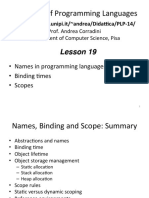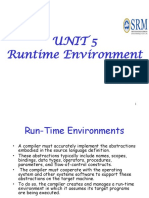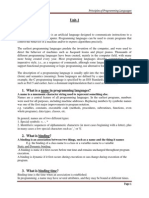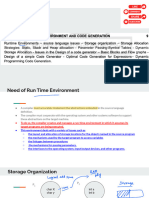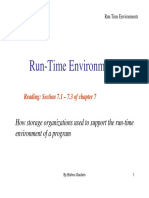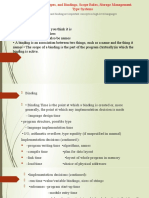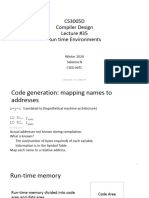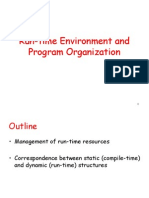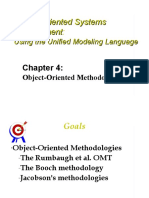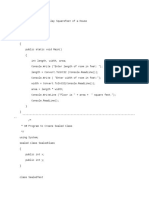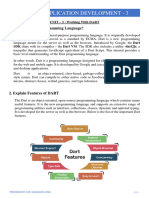The University of North Carolina at Chapel Hill
COMP 144 Programming Language Concepts
Spring 2003
Binding Time and Storage Allocation
Stotts, Hernandez-Campos
Review: Compilation/Interpretation
Source Code
Compiler or Interpreter Translation Execution
Interpretation
Target Code
2
Phases of Compilation
High-Level Programming Languages
Two main goals:
Machine independence Ease of programming
High-level programming language are independent of any particular instruction set
But compilation to assembly code requires a target instruction set There is a trade-off between machine independence and efficiency
E.g. Java vs. C
Ease of Programming
The driving problem in programming language design The rest of this class
Names Control Flow Types Subroutines Object Orientation Concurrency Declarative Programming
Programming Language
Naming
Naming is the process by which the programmer associates a name with a potentially complicated program fragment
The goal is to hide complexity Programming languages use name to designate variables, types, classes, methods, operators,
Naming provides abstraction
E.g. Mathematics is all about the formal notation (i.e. naming) that lets us explore more and more abstract concepts
Control and Data Abstraction
Control abstraction allows the programmer to hide an arbitrarily complicated code behind a simple interface
Subroutines Classes
Data Abstraction allows the programmer to hide data representation details behind abstract operations
ADTs Classes
Binding Time
A binding is an association between two things
E.g. Name of an object and the object
Binding time is the time at which a binding is created
Language design time Language implementation Program writing time Compile Time Link Time Load Time Run Time
8
Binding Time Impact
Binding times have a crucial impact in programming languages
They are a fundamental design decision
In general, early binding is associated with greater efficiency
E.g. C string vs. Javas StringBuffer
In general, late binding is associated with greater flexibility
E.g. Class method vs. Subroutine
Compiled languages tend to bind names earlier than interpreted languages
9
Object Lifetime
Events in the life of an object
Creation Destruction Creation Destruction
A binding to an object that no longer exists is called a dangling reference
Object Lifetime
Events in the life of a binding
Deactivation and Reactivation
10
Storage Allocation Mechanisms
In static allocation, objects are given an absolute address that is retained throughout the programs execution
E.g. Global variables, Non-recursive Subroutine Parameters
11
Static Allocation
12
Storage Allocation Mechanisms
In static allocation, (static) objects are given an absolute address that is retained throughout the programs execution
E.g. Global variables, Non-recursive Subroutine Parameters
In stack-based allocation, (stack) objects are allocated in last-in, first-out data structure, a stack.
E.g. Recursive subroutine parameters
13
Stack-based Allocation
14
Calling Sequence
On procedure (method) call and return compiler generates code that gets executed to manage the runtime stack Setup at call to procedure doFoo(a,b)
Prologue before doFoo code itself
Epilogue at end of doFoo code Teardown in calling code right after call
15
Calling Sequence
Setup at call to procedure doFoo(a,b)
Move sp to allocate a new stack frame Copy args a,b into frame Copy return address into frame Set fp to point to new frame maintain static chain or display
Prolog before procedure code itself
Copy registers into local slots Object initialization
16
Calling Sequence
Epilog at end of procedure code
Placing return value into slot in frame Restore registers Restore PC to return address
teardown in calling code right after call
Move sp (deallocate frame) Move fp using dynamic chain Maybe move return values (if in registers)
17
Calling Sequence: Perl
In Perl you have to manages some of the calling sequence yourself
&doFoo($a, $b, \@ar5);
sub doFoo { my ($arg1, $arg2, $ref1) = @_ ; # aha! # not quite the same $@_[0] = 4; $@_[1] = $$@_[2][7]; # etc is ok
}
18
Storage Allocation Mechanisms
In static allocation, (static) objects are given an absolute address that is retained throughout the programs execution
E.g. Global variables , Non-recursive Subroutine Parameters
In stack-based allocation, (stack) objects are allocated in last-in, first-out data structure, a stack.
E.g. Subroutine parameters
In heap-based allocation, (heap) objects may be allocated and deallocated at arbitrary times
E.g. objects created with C++ new and delete
19
Heap-based Allocation
The heap is a region of storage in which subblock can be allocated and deallocated
This not the heap data structure
Oops no fit
20
Heap Space Management
In general, the heap is allocated sequentially This creates space fragmentation problems
Internal fragmentation
If size of object to allocated is larger than the size of the available heap Come from fixed size heap blocks
External fragmentation
If size of object to allocated is not larger than the size of the available heap, but the available space in the heap is scattered through heap in such a way that no contiguous space fits Comes from variable size blocks
21
Heap Space Management
Some languages (C) require (allow) explicit heap management
allocation and de-allocation of dynamic storage by the programmer
malloc, return
Easy to forget return Heap fills with objects no longer in use (dangling refs) Memory leaks heap gets exhausted
22
Heap Space Management
Some languages (Java) manage the heap for you
new( ) object allocated on heap when done, the object storage is reclaimed
Automatic de-allocation after an object has no bindings/references is called garbage collection
E.g. Java some runtime efficiency hit no memory leaks
23
Sample Memory Layout
code
Globals, consts
runtime stack
(Ret add for inDo call)
heap
(direction of growth)
foo inDo p1 sum
Stack frame for inDo call
0000
R1 (pc) R2 (sp) R3 (fp)
6024
3125 217560 218380
6356
275000 Machine memory addresses
975000
24
Reading Assignment
Scotts chapter 3
Section 3.1 Section 3.2
25




